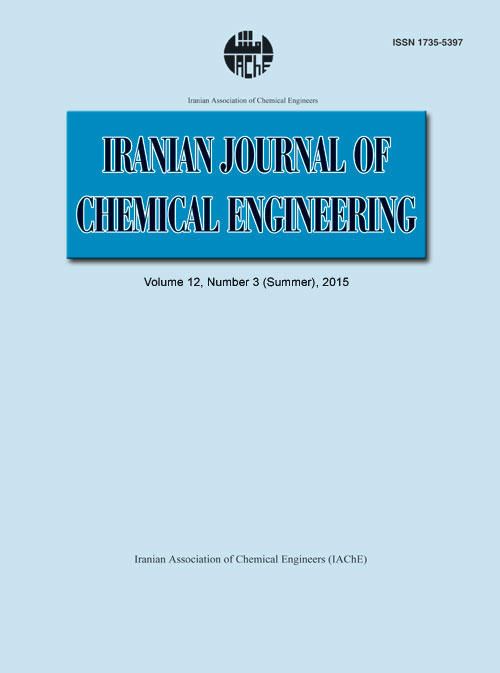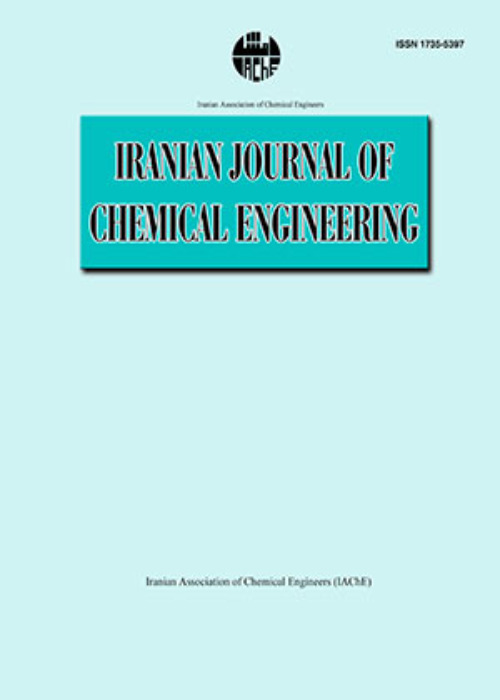فهرست مطالب

Iranian journal of chemical engineering
Volume:12 Issue: 3, Summer 2015
- تاریخ انتشار: 1394/07/23
- تعداد عناوین: 7
-
-
Pages 3-14The CeMnO2 supports were prepared via co-precipitation method by ammonia as precipitating agent. The CuO/CeO2 and CuO/Ce(1-x)MnxO2 (x=0.1, 0.3 and 0.5) catalysts were synthesized by wet impregnation method. The physicochemical properties of the prepared CuO/Ce(1-x)MnxO2 catalysts were characterized by N2 adsorption-desorption, powder X-ray diffraction (XRD) and programmed H2 temperature reduction (H2-TPR). The effects of Cu and Mn loading were investigated on the catalytic performance. The findings illustrated that the 7% CuO/Ce0.9Mn0.1O2 catalyst shows high activity for CO-PrOx. The high activity of 7% CuO/Ce0.9Mn0.1O2 catalyst was ascribed to high surface area of the support, synergetic effects of CuO and CeO2 and increases of the mobility of lattice oxygen in ceria by addition of MnO2. The effects of presence of H2O in the reaction feed stream, oxygen to CO ratio (λ) and gas hourly space velocity (GHSV) on the catalytic activity of 7% CuO/Ce0.9Mn0.1O2 were evaluated. It was found that the best performance of 7% CuO/Ce0.9Mn0.1O2 catalyst was obtained at λ=2, GHSV=20000 h-1 and in addition, the presence of H2O had negative effects on the activity of the catalyst. In the long term stability test, nearly 100% CO conversion was maintained for 50 h at 120°C with 70-80% CO2 selectivity.Keywords: Cu, CeMnO2 Catalyst, CO oxidation, PrOx, Hydrogen
-
Pages 15-31The osmotic dehydration of three agricultural products including carrot, zucchini and turnip has been studied in this research. The effect of several factors including temperature, sample to osmotic solution weight ratio and the concentration of the osmotic solutes on the osmotic dehydration of these agricultural products were investigated experimentally. The experimental studies consist of two different concentrations (10%, and 20 W/W% for carrots, 30%, and 50 W/W% for zucchini and 40%, and 50 W/W% for turnips), two different vegetable/solution weight to weight ratios (1:10 and 1:15 for all materials) and two different temperatures (30°C and 50°C for carrots and zucchini and 40°C and 50°C for turnips). Three dietary coatings including pectin, carboxymethyl cellulose and corn starch have been selected to control the solids uptake during the osmotic process. The Azuara model proved to be the most accurate correlation to describe the kinetics of the osmotic dehydration of these three agricultural products. The root mean square error of the Azuara model for solid gain in different conditions was between 0.014 and 0.065 for carrots, 0.011 and 0.030 for zucchini and 0.008 and 0.014 for turnips. The root mean square error of the Azuara model for water loss in different conditions was between 0.008 and 0.016 for carrots, 0.003 and 0.008 for zucchini and 0.009 and 0.017 for turnips.Keywords: Osmotic Dehydration, Drying, Azuara Model, Carrot, Zucchini, Turnip
-
Pages 32-40In the present study, transesterification of soybean oil to Fatty Acid Methyl Ester (FAME) was carried out in the microreactor. The system performance was investigated in the presence of hexane as a cosolvent. Furthermore, the effect of number of micromixer’s inlets on the mixing was one of the objectives in this work. For the goals mentioned above, three different experiments were done with and without cosolvent in two and three inlet micromixers under optimum conditions. Both flow pattern observations and Gas Chromatgoraphy (GC) characterization of FAME samples demonstrated that cosolvent technique and micromixer application could significantly influence the FAME yield in biodiesel production.Keywords: Biodiesel, Cosolvent, Flow Pattern, Micromixer, Transesterification
-
Pages 41-54Sodium montmorillonite (Na-MMT) was organically modified using 11-aminoundecanoic acid (AUA) and methacryloxyethyltrimethylammonium chloride (MAETAC) via cation exchange reaction. The effect of the modifier type and concentration on the structure and surface properties of the organically modified montmorillonites (OMMTs) was investigated. According to the results, the basal spacing of organoclays was enlarged considerably with increasing the AUA concentration, while increasing the MAETAC concentration had no significant influence on OMMT’s gallery height. On the other hand, contact angle measurements revealed that increasing the modifiers concentration would increase the hydrophobicity of pristine montmorillonite. The FTIR spectra showed that the OMMTs interlayer environment changed from liquid-like to solid-like as the modifier concentration increased. A mean-field lattice-based model was applied to various polymer/OMMT systems to predict the affinity between the prepared OMMTs and some polymers with different hydrophobicity. The model results showed that high polar and hydrophilic polymers, such as poly(ethylene oxide), exhibit more negative free energy change and stronger interaction with the OMMTs and, consequently, higher potential for preparation of composites with desirable nanostructure and mechanical properties.Keywords: Contact Angle, Montmorillonite, Mean, Field Lattice, Based Model, Nanocomposite
-
Pages 55-76Waste cooking oil (WCO) is being generated large scale all over the world; hence it has devised serious problems of its waste management. Organised collection of WCO in voluminous quantity is mainly used for the production of biodiesel. Most researchers focus primarily on the biodiesel generation from WCO, although other applications are also important and require attention. Objective of this review article is to highlight most of the aforementioned possible applications of WCO which may help in its utilization apart from biodiesel. It can be processed to obtain pyrolytic oil, hydrogen gas, biodiesel or electricity production by direct burning. Applications like combined heat and power generation (CHP) can utilize WCO with utmost efficiently. It can also be processed chemically to obtained biodegradable polyurethane sheets, greases, biolubricants, soaps and alkyd resins. Properly purified and sterilized WCO can be used as a carbon source in fermentation processes for the production of rhamnolipid biosurfactant and polyhydroxybutyrate (PHB). Waste cooking oil therefore can be considered as a potential waste which can be utilized as energy source and raw material for chemical or biological processes.Keywords: Waste Cooking Oil (WCO), Combined Heat, Power (CHP), Pyrolytic Oil, Hydrogen
-
Pages 77-95In this study a new and robust procedure is presented to solve synthesis of isothermal reactor networks (RNs) which considers more than one objective function. This method uses non-dominated sorting genetic algorithm II (NSGAII) to produce structural modification coupled with quasi linear programming (LP) method for handling continuous variables. The quasi LP consists of an LP by adding a search loop to find the best reactor conversions as well as split and recycle ratios which are much easier to solve. To prevent complexity and ensure optimum solution, only ideal continuous stirred tank reactors (CSTRs), plug flow reactors (PFRs) and PFR with recycle stream are considered in producing reactor networks. Also, to avoid differential equations which appear in design equations of PFR reactors, CSTRs in series are replaced for each PFR. Results show that the proposed method finds better solutions than those reported in the literature.Keywords: Isothermal reactor networks synthesis, NSGAII, Quasi linear programming method, Multi objective function, structural, continuous variables
-
Pages 96-105The aim of the current research is concentrated on the synthesis of the different nanoparticles such as SnO2 and ZnO nanoparticles and SnO2-ZnO hybrid via sol gel method to investigate their photocatalytic applications for removal of methyl orange pollutant in water. Therefore, ZnCl2 and SnCl2.2H2O were used as ZnO and SnO2 source respectively. The samples were characterized by X-ray diffraction (XRD) spectroscopy, Fourier transform infrared spectroscopy (FTIR) and UV-Vis spectroscopy. XRD results revealed that the crystalline structure of SnO2 and ZnO nanoparticles were formed. FTIR analysis confirmed the presence of ZnO and SnO2 nanoparticles. Optical properties of samples measured using UV-Vis spectrophotometer and the achieved results demonstrated that the photocatalytic activity of SnO2-ZnO hybrid for the degradation of methyl orange is higher than that of SnO2 nanoparticles and lower than that of ZnO nanoparticles. Weight fraction dependence study also showed that the degradation of methyl orange dye increases with weight fraction. The experimental results revealed that after 35 min UV light irradiation, the photocatalytic degradation of MO using 0.5 g ZnO, hybrid of ZnO- SnO2 and SnO2 nanoparticles reached to 99.35%, 92.14% and 87.91%, respectively. In addition, maximum removal efficiency of MO was related to the suspension containing of 0.5 g of ZnO hybrid equal to 99.35%.Keywords: SnO2 Nanoparticles, ZnO Nanoparticles, SnO2, ZnO Hybrid, Photocatalytic Activities, Methyl Orange


